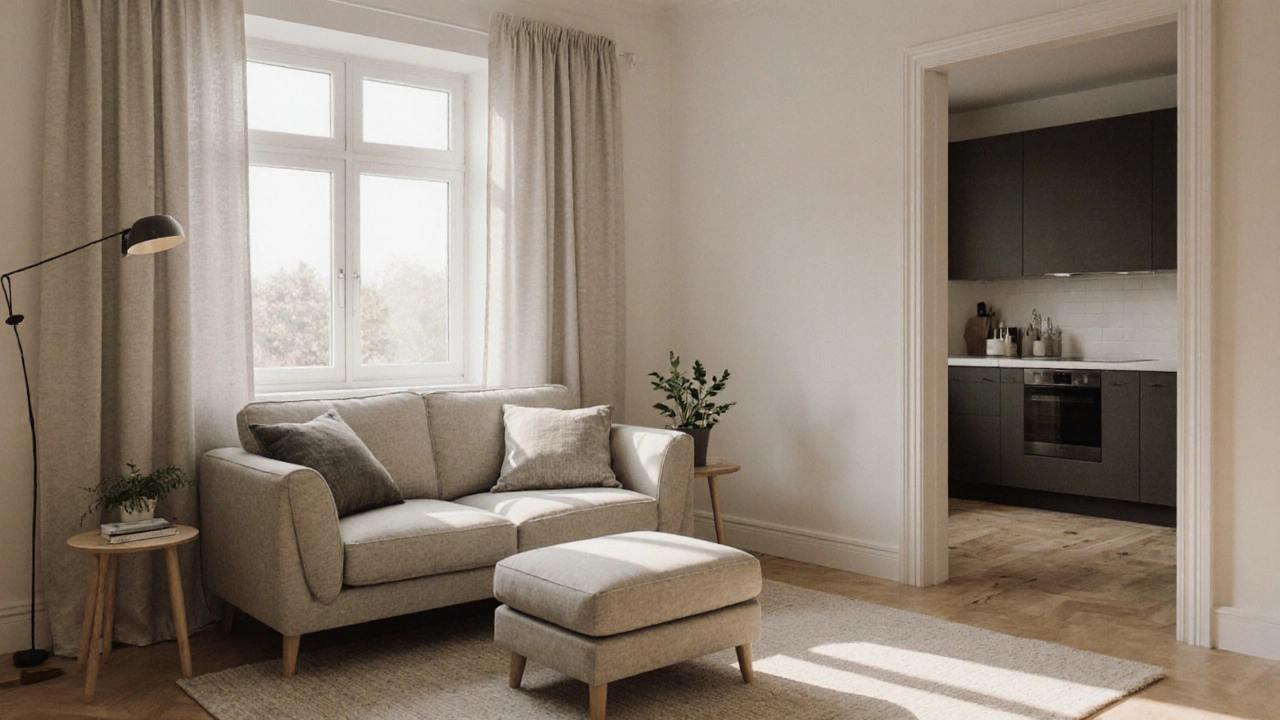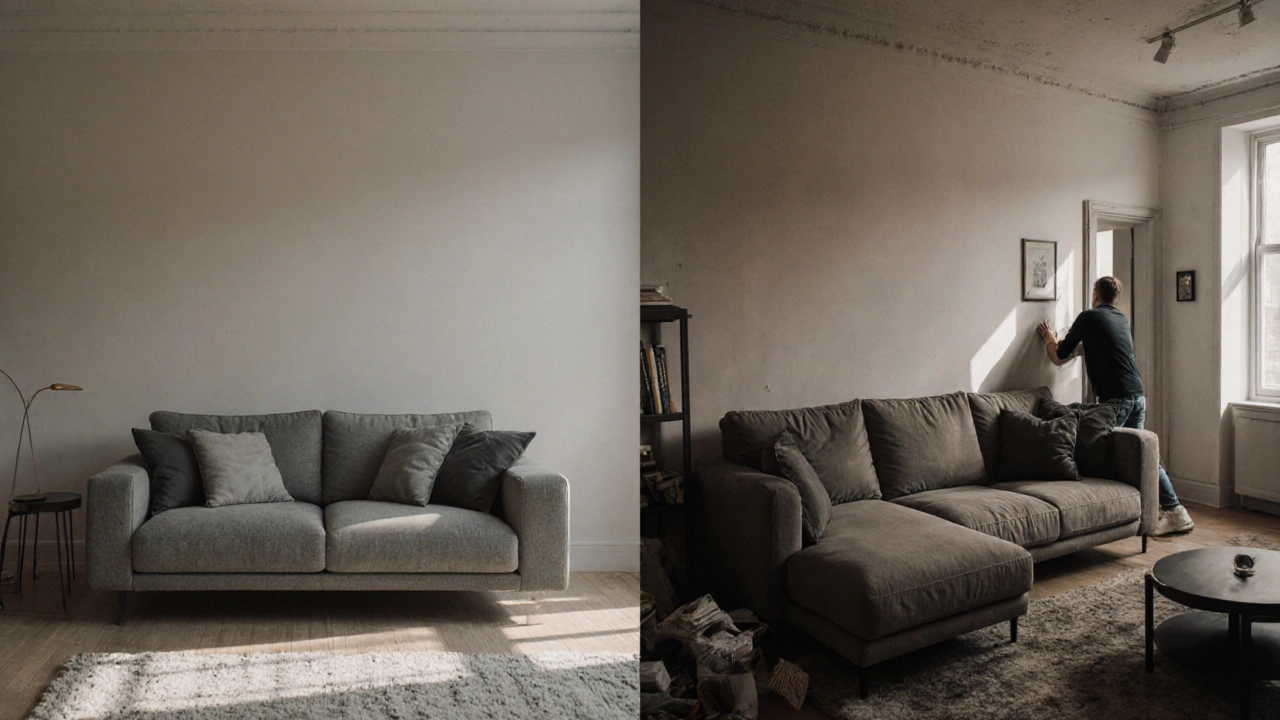Is a Couch or Sectional Better for Your Living Room?
 Oct, 27 2025
Oct, 27 2025
Couch vs Sectional Decision Tool
This tool helps you decide whether a couch or sectional is better for your living room based on your specific space, lifestyle, and budget. Answer a few questions to get a personalized recommendation.
Recommendation
Why this is recommended:
Additional tips for your situation
Choosing between a couch and a sectional isn’t just about style-it’s about how you actually live in your space. If you’ve ever stared at a showroom floor wondering which one fits your life better, you’re not alone. The right choice can turn your living room into a cozy hangout or leave you stuck with something that feels too big, too awkward, or just doesn’t work.
What’s the real difference?
A couch is a single-seater or two-seater sofa, usually straight and simple. A sectional is made of multiple pieces-often a couch plus one or more chaise lounges or corner units-that connect to form an L-shape, U-shape, or even a curved layout. It’s not just bigger; it’s modular. That means you can rearrange it, add pieces later, or reconfigure it when your space changes.
But here’s the thing: size isn’t everything. A 90-inch couch might be perfect for a small apartment in Ponsonby, while a 12-foot sectional could swallow up the whole living area in a North Shore bungalow. The key is matching the shape to the room, not just the number of people who sit on it.
Who wins for small spaces?
If your living room is under 12 square meters, a standard couch is almost always the smarter pick. Sectionals look impressive in magazines, but in tight spaces, they can block doorways, make it hard to walk around, and turn your room into a maze. I’ve seen too many clients regret buying a sectional because they couldn’t get past it to reach the kitchen.
A compact two-seater couch with a matching ottoman gives you flexibility. You can pull the ottoman in front for feet-up lounging, or move it aside when you need clear walking space. It’s easier to clean around, easier to move if you ever relocate, and it doesn’t dominate the room visually.
There’s one exception: if your room has an awkward corner you can’t use, a corner sectional might actually free up floor space. A well-placed L-shaped sectional can turn a dead zone into a seating nook. But only if the corner is truly unused. Don’t force a sectional into a room that doesn’t want it.
Who wins for families and entertaining?
If you host friends often, have kids, or just love sprawling out on weekends, a sectional is the clear winner. More seating. More legroom. More places to tuck in a toddler or nap after dinner. A sectional with a chaise lets one person stretch out while others sit upright-perfect for movie nights or Sunday afternoon reading.
Real-life example: A couple in Mt. Eden bought a deep-seated sectional with removable, washable covers. They have two young kids and a dog. The sofa gets used daily-not just for sitting, but for climbing, drawing on the floor, and napping. The covers come off for the washing machine. The sectional didn’t just fit their space-it adapted to their chaos.
Sectionals also make it easier to group people. Instead of scattering chairs around the room, everyone naturally gathers in one connected unit. It feels more intimate, even in a larger room.

What about style and resale value?
Style-wise, couches feel more traditional and streamlined. They work well in minimalist, Scandinavian, or mid-century homes. Sectionals lean modern, industrial, or contemporary. But that’s not a hard rule. You can find sleek, low-profile sectionals and chunky, classic couches too.
Resale value? Couches are easier to sell. They’re smaller, easier to transport, and fit into more homes. Sectionals can be a hard sell unless they’re high-end or modular. Buyers often worry about fitting it through doors or matching it to their existing layout. If you plan to move in the next few years, a couch gives you more flexibility.
Cost and maintenance
Generally, a good-quality couch costs between NZ$800 and $2,000. A sectional? Start at $1,800 and go up to $5,000 or more, depending on materials and brand. That’s a big jump. But here’s the catch: sectionals often come with more features. Built-in storage, reclining seats, or modular pieces that can be replaced individually. Some brands even let you swap out cushions or arms years later.
Maintenance? Both need regular vacuuming and spot cleaning. But sectionals have more seams, more fabric surfaces, and more nooks where crumbs and pet hair hide. If you have pets or kids, go for performance fabric-like Crypton or Sunbrella-that repels stains and resists odors. Avoid velvet or light linen on a sectional unless you’re ready to clean daily.
When to choose a couch
- Your living room is under 12 square meters
- You want to keep the space open for movement
- You plan to move in the next 3-5 years
- You prefer a clean, uncluttered look
- You don’t need extra seating often

When to choose a sectional
- You have a large or L-shaped room
- You entertain guests regularly
- You have kids, pets, or like to lounge
- You want flexible seating that grows with your needs
- You’re okay with higher upfront cost and bigger footprint
Pro tip: Test before you buy
Measure your space. Then measure your doorways, hallways, and stairwells. A sectional that looks perfect in the store might not fit through your front door. I’ve seen people return $3,000 sofas because they didn’t check the delivery path.
Also, sit on it. Don’t just glance at the fabric. Sit like you would at home-lean back, stretch out, cross your legs. Does it support your lower back? Is the seat depth too deep or too shallow? A couch that’s too shallow feels like you’re perched on the edge. A sectional with too-deep seats can make you sink in like a hammock.
Try both. If you can, visit a store with both a couch and a sectional in the same style and fabric. Sit on each for five minutes. Your body will tell you which one feels right.
Final thought: It’s not about what looks good-it’s about what works for you
There’s no universal answer. A couch isn’t outdated. A sectional isn’t always the best. The right choice depends on your room, your habits, your budget, and your future plans. Don’t let Instagram trends dictate your living room. Look at how you live. Do you curl up alone with a book? Go for a couch. Do you host game nights with six friends and three dogs? Go for a sectional.
Your furniture should serve your life-not the other way around.
Can a sectional fit in a small apartment?
Yes, but only if your apartment has a corner that’s unused and the sectional is designed for small spaces. Look for compact L-shapes under 2.5 meters wide. Avoid bulky, deep-seated models. Always measure your entry points-many sectionals can’t fit through standard doors without disassembly.
Is a sectional more expensive than a couch?
Yes, typically. A good couch costs between NZ$800 and $2,000. A sectional starts around $1,800 and can go over $5,000. But sectionals often include more features like storage, recliners, or modular pieces that can be replaced later, which can make them more cost-effective long-term if you plan to keep them for years.
Can I add a chaise to a regular couch later?
Usually not. Couches and sectionals are built as separate units. You can’t attach a chaise to a standard couch unless it’s specifically designed as a modular system. If you think you might want extra seating later, buy a sectional from the start.
What fabric is best for a sectional with pets?
Choose performance fabrics like Crypton, Sunbrella, or microfiber. These resist stains, odors, and pet hair. Avoid velvet, silk, or light-colored linen-they show every scratch and paw print. Darker colors also hide dirt better. Always ask for a fabric sample and test it with water and a little pet hair before buying.
Do sectionals make a room look smaller?
They can, if they’re too big or placed poorly. But a well-sized sectional that hugs a corner can actually make a room feel more organized by defining the seating area. The key is proportion. A sectional that takes up half the room will overwhelm it. One that fits snugly into a corner creates a cozy, intentional layout.
How long do couches and sectionals last?
A well-made couch lasts 7-12 years. A sectional can last longer-10-15 years-if it’s modular and you replace worn pieces. High-density foam, hardwood frames, and quality stitching make the difference. Cheaper models, regardless of type, start sagging after 3-5 years.